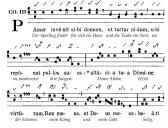Unusual accidentals? In my antiphons? It's more likely than you think.
-
I was browsing Joerg's OCO2015 pdf to learn some of the Holy Week antiphons, and saw something I've never seen before: F-sharp?! Since when are they putting F-sharps in chant? It's not that I think it's a bad idea; this particular piece sings better with an augmented fourth than without, recasting a hopeful text into something like a major key. But I've only ever seen B-flats before.
Only one of Gregobase's 3 versions of this text use a fa-sharp, and the source for this version is something called "Verona", which isn't a hugely helpful or googlable reference. Cantus, out of ten melodies for this, doesn't show any using fa-sharp. So where does this come from and why is it the odd one out?
 f sharp.png543 x 256 - 36K
f sharp.png543 x 256 - 36K -
DCM,
There is another F in the piece, down an octave, which is not sharped.
If I had to guess, it's a well-meaning misprint. -
A few other things occur to me:
1: The incipit starts on D and ends on G, so there's a nice interplay between the expectations of the two major scales that start on those notes. In both, F is sharp. You start on D and climb up to what's functionally a major third. Then, as you slide downward, the C-natural shifts you into a different key and pushes you toward G as the final.
2; Since I'd be chanting the psalm text (72:12-19) in English, I'd be using Meinrad tone 7, which uses F as the reciting tone in the second bar. This obviously doesn't pair well with the antiphon as printed.
3: If you're chanting the psalm in Latin, tone 7 hits an F in the first cadence, which also doesn't pair well with the antiphon as printed. The reciting tone is D, but it starts on C so there's no expectation of an augmented fourth.
4. As printed, its a lovely melody which fits the mood of the text (after all, why would you sing "liberavit" on a minor third?), but it doesn't pair well at all with any of the typical psalm tones.
5. One could retranscribe the incipit downward a full tone, turning that F-sharp into an E and the C into a B-flat. This preserves the "major" feel of the incipit and produces a score that looks "normal." This does slightly narrow the melodic range but the mood is the same. This score is a nice compromise. -
DCM,
When the Gregorian chants were assembled, G-major and D-major were foreign concepts. -
This is the so called transposed 7th mode. In the usual 7th mode the sequence of two whole steps on the syllable -ra- can not be notated. So one can either transpose the piece down a fourth (Cf. e.g. Caro mea: gregobase 10086, Me suscepit: gregobase 9095), but then the psalm has to be transposed as well, or one introduces the sharp sign and then one can use the ordinary 7th mode for the psalm. So it's just a matter of notation.
-
-
Transpose down a fifth? ... not a fourth, which would yield a C-sharp.
It's better to B-natural and down a fifth.Thanked by 1Andrew_Malton -
We all use scandalous scores sometimes

 502161CD-BE1D-4AEE-9C9D-B5926720701C.jpeg1541 x 1173 - 438K
502161CD-BE1D-4AEE-9C9D-B5926720701C.jpeg1541 x 1173 - 438K -
Making Passer invenit even weirder... impossible!Thanked by 1tomjaw
Welcome to the MusicaSacra Forum!
To participate in the discussions on Catholic church music, sign in or register as a forum member, The forum is a project of the Church Music Association of America.
Categories
- All Discussions21,108
- General Music Discussion8,218
- Job Openings197
- Management of Music Programs850
- Choral Matters533
- Church Documents and Rubrics524
- CMAA Notes302
- Events716
- For Newcomers: Read First26
- Sacred Polyphony546
- Hymnody872
- Gregorian Chant: General2,698
- ↳ Graduale Romanum and Liber Usualis368
- ↳ Graduale Simplex60
- ↳ Semiology63
- Vernacular Plainsong696
- Anglican Use and Anglican Chant68
- Organ, Other Instruments and Repertoire435
- New Composition/Works in Progress1,291
- Recordings231
- Music for Hispanic Ministry159
- Music Education: Children211
- Music Education: General222
- News Items245
- Positions Wanted2
- General Discussion: Catholicism739
- Amusements177
- General Discussion1,033
- Opinions117



